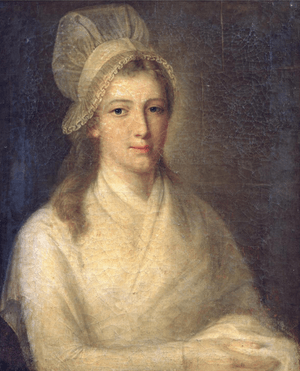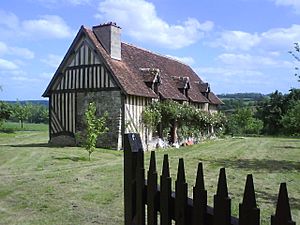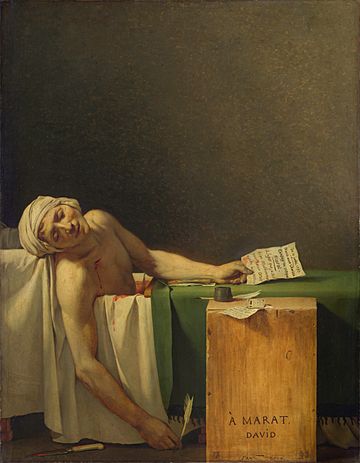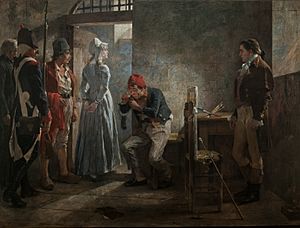Charlotte Corday facts for kids
Quick facts for kids
Charlotte Corday
|
|
|---|---|

Charlotte Corday, painted at her request by Jean-Jacques Hauer, a few hours before her execution
|
|
| Born |
Marie-Anne Charlotte de Corday d'Armont
27 July 1768 |
| Died | 17 July 1793 (aged 24) |
| Cause of death | Execution by guillotine |
| Known for | Assassination of Jean-Paul Marat |
| Parent(s) |
|
| Signature | |
 |
|
Marie-Anne Charlotte de Corday d'Armont (born July 27, 1768 – died July 17, 1793), known as Charlotte Corday, was an important person during the French Revolution. In 1793, she was put to death by guillotine. This was because she killed Jean-Paul Marat, a powerful leader of the Jacobins.
Marat was a politician and journalist. He helped make the Revolution more extreme. He also played a big part in removing the Girondins, a group Corday supported. Later, a writer named Alphonse de Lamartine called Corday "the Angel of Assassination."
Contents
Charlotte Corday's Early Life

Charlotte Corday was born in a small village called Saint-Saturnin-des-Ligneries, in Normandy, France. Her family was part of the lower nobility. She was also a descendant of the famous French writer Pierre Corneille.
When Charlotte was young, her older sister and mother passed away. Her father, Jacques François de Corday, sent Charlotte and her younger sister to a convent in Caen. At the convent, Charlotte could read many books. She discovered the writings of Plutarch, Rousseau, and Voltaire. These books helped shape her ideas.
After 1791, she lived in Caen with her cousin. They became very close. Corday was described as having auburn hair and gray eyes.
Why She Acted: Political Beliefs
As the French Revolution became more violent, Charlotte Corday began to support the Girondins. This group believed in a more moderate approach to the Revolution. They were worried about how extreme things were becoming.
The Girondins were against another group called the Montagnards. The Montagnards, including Marat, wanted the Revolution to be very radical. They believed that using terror and executing opponents was the only way to save France. Corday felt that the Girondins could save France from this extreme violence.
Corday's actions challenged the usual ideas about women's roles in society. Some people saw her as a hero for standing against Marat's ideas. At her trial, Corday famously said, "I have killed one man to save a hundred thousand." This showed her belief that she was stopping more violence.
The Killing of Marat
Jean-Paul Marat was a powerful member of the radical Jacobin group. He was very influential through his newspaper, L'Ami du peuple ("The Friend of the People"). Corday decided to kill Marat because she was horrified by the September Massacres of 1792. These were very violent events that she blamed Marat for. She also feared that Marat was pushing France towards a full civil war. Corday believed that Marat's death would bring peace to the country. She also felt that King Louis XVI should not have been executed.

On July 9, 1793, Corday traveled to Paris. She rented a room and bought a kitchen knife. Over the next few days, she wrote a letter called Adresse aux Français amis des lois et de la paix (Address to the French, friends of Law and Peace). In this letter, she explained why she planned to kill Marat.
Corday first wanted to kill Marat in front of the National Convention. She wanted to make a public statement. However, she learned that Marat was too sick to attend meetings. He suffered from a severe skin condition.
So, Corday changed her plan. On July 13, she went to Marat's home. She claimed to have important information about a Girondist uprising in Caen. Marat's fiancée's sister, Catherine Evrard, turned her away.
Corday returned that evening. This time, Marat allowed her to enter. He was in his bathtub because of his skin condition. Marat wrote down the names of the Girondins that Corday gave him. Then, Corday pulled out her knife and stabbed him in the chest. Marat cried out, "Help me, my dear friend!" and then died.
This moment is famously shown in Jacques-Louis David's painting The Death of Marat. Another painting, Charlotte Corday by Paul-Jacques-Aimé Baudry, also shows Marat in his bath.
After Marat's cry, his fiancée's sister rushed in. A newspaper distributor also came and grabbed Corday. Doctors tried to save Marat, but it was too late. Officials arrived to question Corday and calm the angry crowd.
Her Trial

Charlotte Corday wrote a farewell letter to her father. This letter was found and read during her trial. It showed that she had planned Marat's murder beforehand.
In the letter, she asked her father for forgiveness. She wrote that she had "avenged many innocent victims" and "prevented many other disasters." She believed that the people would one day be happy to be free from a "tyrant." She ended the letter with a line from her ancestor Corneille: "Crime is shame, not the scaffold!"
Corday was questioned three times by important revolutionary judges. She insisted that she was a republican. She said she had been one even before the Revolution began. She used the values of ancient Rome as her ideal.
The main question was whether she was part of a larger plot by the Girondins. Corday always said, "I alone conceived the plan and executed it." She called Marat a "monster" who was only respected in Paris. She said her single, fatal stab was due to luck, not practice.
Corday asked for Gustave le Doulcet, an old friend, to defend her. However, he did not receive her letter in time. So, Claude François Chauveau-Lagarde was chosen to defend her instead.
Execution

After she was sentenced, Corday asked the court if she could have her portrait painted. She said she wanted to record her true self. She chose Jean-Jacques Hauer, a National Guard officer, as the artist. Hauer had already started sketching her in the courtroom. His painting (shown at the top of this article) was finished just before Corday was taken to the tumbril (a cart used to carry prisoners). She looked at it and suggested a few changes.
Some writers have described Corday as having blonde hair because of Hauer's portrait. However, Hauer may have painted her hair lighter to make her look like a vain aristocrat. This would have protected him during that dangerous time. Many other paintings, and her passport, describe her hair as "chestnut" (brown).
On July 17, 1793, four days after she killed Marat, Charlotte Corday was executed. She was guillotined in the Place de Grève in Paris.
Women and the Revolution
Corday's act of killing Marat was seen as a very strong, almost "masculine" action. This event changed how women's political roles were viewed during the French Revolution. Corday herself was surprised by the reaction of other women. She said, "To save your country means not noticing what it costs."
After Corday killed Marat, most women tried to distance themselves from her. They feared that her actions would cause a backlash against the growing feminist movement. Many women also supported Marat's revolutionary ideas and felt sympathy for him.
Images for kids
-
Detail from The Death of Marat by Jacques-Louis David. Marat's dead hand grips a piece of bloody paper which reads, "July 13, 1793. Marie Anne Charlotte Corday to Citizen Marat. Suffice it to say that I am very unhappy to be entitled to your benevolence."
See also
 In Spanish: Charlotte Corday para niños
In Spanish: Charlotte Corday para niños






